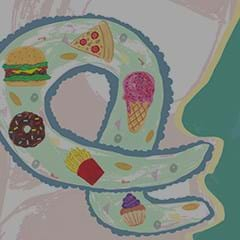As the world focuses on the importance of curbing obesity to combat COVID-19, it’s critical that we assess health using the smartest measures – and weight is not one of them. Performance Physiologist, Professor Paul Laursen says we need to measure what matters – and that is fat! Or more specifically, ‘overfatness’.
The term overfat refers to the presence of excess body fat that can impair health, even for normal weight non-obese individuals. Research suggests that in the top 30 industrialized countries more people are overfat than there are obese and overweight people globally. Shockingly, up to 90 percent of US males and 80 percent of US females are overfat. It seems incredible – even people who look slim and fit can be classified as being overfat.
We sat down with Laursen to find out how you can spot the overfat warning signs and take action to prevent overfatness from impacting your health.
If the majority of us are in the same boat are we simply over-diagnosing? What’s the point in even putting a name on overfatness?
PAUL LAURSEN: The point in knowing about overfat is that it creates awareness and gives people the opportunity to do something about it. By finding out whether you’re in the overfat category, you can establish whether you’re increasing your risk for a bunch of downstream diseases, and ultimately the risk of earlier death. Falling into the overfat category means you’ll probably have an underlying systemic level of inflammation, and a lower quality of life – you know, a lack of physical ability and more potential for injury. And then there are all the scarier issues, such as cancer, cardiovascular disease and dementia. If you’re in the overfat category you’re just increasing your risk of suffering from them sooner in your life rather than later.
We’re not necessarily talking about fat you can actually see or pinch around your middle, so how do you know if you’re overfat?
The model for measuring overfat has purposely been kept very simple so that everyone can use it as a measure and find out if they're at risk. You can assess yourself using your waist to height ratio – if you measure your waist size, multiply that by two, and it is larger than your height, then there's a good chance that you fall into the overfat category. Of course, this is just an indicator, as the dangerous inflammatory or visceral fat doesn't always go hand-in-hand with larger waistlines. Often, people can appear slim and perfectly healthy on the outside, but on the inside it’s an entirely different story.
You can assess yourself using your waist to height ratio – if you measure your waist size, multiply that by two, and it is larger than your height, then there’s a good chance that you fall into the overfat category.
Based on this measure, there’s likely to be a lot of people who previously thought they were fit and healthy, yet are now lumped in with those who are seriously obese. How should these people handle this new information?
It all comes down to the individual – if an individual can help themselves and get a little more educated on the issue, they could potentially improve their own chances of lengthening their life, improving their quality of life.
But surely there are degrees of overfatness? Should we be identifying those who are more at risk than others?
You can see those who are at the most risk. If they have a large amount of fat deposition in the abdominal region, around the organs, that’s the dangerous fat.
You can establish a more precise degree of overfat with a DXA, that's a dual-energy X-ray absorptiometry scan that can measure body fat percentage. Basically, you sit in this little tube and it scans you using X-rays. It's the current gold standard marker of body fat percentage and there are plenty of clinics offering DXR scans. The price point is coming down a lot, you can get them for as little as US$50. Our most recent studies indicate the general ballpark cut-off for body fat percentage is around the 30 percent mark for females and the 17 percent mark for males. So if you have a DXA scan and your body fat percentage is above this you might want to have a look at making some changes.
So should we now focus on measuring overfat (our height in relation to our waistline) instead of our BMI (our height in relation to our weight)? Is there much difference?
The BMI measurement is poor because it misclassifies individuals. So many people can step on the scales and be within a normal BMI – you know, their weight divided by their height squared winds up being okay – but it’s just actually measuring weight. And weight can mean a bunch of different things. After all, if you’re someone with osteoporosis, then all of a sudden you have light bones. Or if you’re an elite athlete, chances are your muscle will make you obese on the BMI scale. Take the All Blacks [New Zealand's world champion rugby team], elite athletes who are true specimens of health – yet based on BMI these guys are obese. I mean seriously, does that make any sense?
"We got this wrong a long time ago, and now we need to back the truck up and start again to understand what matters and measure what matters."
One of my key mantras is, understand what matters and then measure what matters. We know what matters to your health is your level of visceral fat. And now we’re measuring what matters, which gives us your level of overfatness. Weight is kind of irrelevant.
So what matters is visceral fat, otherwise known as belly fat. What about other areas of fat, love handles for example?
It’s the fat deep in the middle area, around the organs, that is problematic – although love handles are also fat, which is an issue. When love handles form it’s just fat looking for other places to go. There’s a reason it’s going there, to get rid of the excess glucose that’s sitting in your bloodstream. That glucose is a toxin, and it’s your body’s job to get rid of that and get that level down.
How can we cut the fat?
The big one is sugar. I mean it's pretty well established that sugar is a big problem – it's the modern-day cigarette. In a very simple model, too much sugar winds up causing too much inflammation and too much visceral fat disposition, which leads to the downstream consequence of disease manifestation. Finding out ways of getting sugar out of your life has got to be the very first step.
So cutting sugar is the start. Where does exercise fit in?
Diet is the more powerful modifier of your level of overfat, or your level of disease risk. You can exercise till the cows come home and you can still have a certain amount of inflammatory or visceral fat, even athletes can be overfat. Of course, exercise is still very important, I am definitely not discounting that. And those who are exercising are going to have a better tolerance for any health issues that do arise.
If even athletes can be at risk of overfatness we can assume that there are a lot of people who exercise every day and think they’re fit and healthy, but they’re still at risk?
You got it! Absolutely. I mean you can go into just about any gym and see people working as hard as they can on that treadmill or whatever machine. They might be pushing a lot of power or moving quite quickly – but that simply indicates fitness, which is different from being healthy. We often put fitness and health together, but fitness is the act of being able to achieve a physical task; health is the symbiosis of all your physiological systems that are working in harmony.
“Exercise is still very important … those who are exercising are going to have a better tolerance for any health issues that do arise.”
So by raising awareness of the term overfat you're hoping that it will raise the health of the planet?
We’re just trying to help society a little bit and create more awareness. It’s not a pretty picture when you look at the burdening health costs in the world. We can’t afford this for too much longer. The world’s health centers and governments are going to be crippled, largely because the food industry has created a system that is difficult to navigate. Essentially, we’ve got to get processed sugar and processed food out of the mainstream diet.
WHAT IS VISCERAL FAT? AND WHY IS IT SO VICIOUS?
- There are lots of names for visceral fat – abdominal adiposity, android obesity, central obesity, hypertriglyceridemic waist, belly fat… Essentially, it’s the fat that sits around your middle.
- But visceral fat is not the type of fat you can pinch. It accumulates well beneath your skin, sitting out of reach deep within your abdominal cavity.
- It is a gel-like fat that wraps around your abdominal organs – your liver, pancreas and kidneys.
- Visceral fat is considered the most toxic, dangerous type of fat as it provokes inflammation and interferes with the body’s normal functions.
- Scientists are finding that excess abdominal fat upsets the balance and functioning of your body’s hormones.
- Visceral fat produces immune system chemicals called cytokines that can increase the risk of cardiovascular disease.
- Too much visceral fat has been linked to everything from increased risk of coronary heart disease, cancer and diabetes to depression, arthritis and sexual dysfunction.

Paul Laursen is a Canada-based Auckland University of Technology Adjunct Professor, performance physiologist and endurance coach. He has published over 100 refereed manuscripts in moderate-to-high impact exercise and sports science journals and is considered an expert on the topic of overfat. He is also a 17-time Ironman finisher who spent seven years leading the Performance Physiology Team at High Performance Sport New Zealand for the London and Rio Olympic cyclists.








